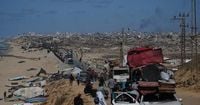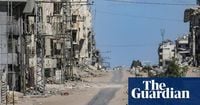On October 1, 2025, Israel’s defense minister issued a chilling ultimatum to the remaining Palestinians in Gaza City: evacuate immediately or be treated as terrorists and face the “full force” of Israel’s military operation. The announcement, delivered by Defense Minister Israel Katz via social media, marked a dramatic escalation in the months-long conflict that has already displaced hundreds of thousands and left Gaza’s civilian population in a state of utter desperation.
“This is the last opportunity for Gaza residents who wish to do so to move south and leave Hamas terrorists isolated in Gaza City,” Katz wrote on X, formerly known as Twitter. He warned, “Those who remain in Gaza will be considered terrorists and terror supporters.” According to the Associated Press, the message was clear: stay behind, and you’ll be in the crosshairs of Israel’s intensifying offensive.
Israel’s military claims to have captured the Netzarim axis, a key corridor stretching from the Mediterranean that now splits the Gaza Strip in two. This move effectively tightens the encirclement of Gaza City, making escape for those still inside even more perilous. The Israel Defense Forces announced that Palestinians fleeing south must now pass through military checkpoints, underscoring the sense of urgency and fear gripping the city’s remaining residents.
The human toll of the conflict continues to mount. Local hospitals reported that at least 21 Palestinians were killed across Gaza on Wednesday alone. The casualties included seven people, among them first responders, killed when two Israeli airstrikes hit a school sheltering displaced families in Gaza City. More than three dozen others were wounded in that attack, according to Al-Ahli Hospital. The violence didn’t stop there: five people died in a strike near a water tank, and additional fatalities were reported in central Gaza and Deir al Balah, including a man killed in his apartment and two people wounded when a tent in the courtyard of Al-Aqsa Martyrs Hospital was hit.
The ongoing bombardment has not spared journalists. On Tuesday, Palestinian freelance journalist Yahya Barzaq was killed in an airstrike while working for Turkish broadcaster TRT. According to the Committee to Protect Journalists, more than 189 Palestinian journalists and media workers have lost their lives to Israeli fire since the war began. The Israeli military has not commented on these incidents, but maintains that it aims to avoid civilian casualties and blames Hamas for embedding its fighters within densely populated areas.
Despite mass evacuations, hundreds of thousands remain trapped in Gaza City. Many are simply too poor or too weak to make the journey south. “We left barefoot,” Hussein al-Del, a recent evacuee, told AP. “The Israelis were striking at random, with no mercy for anyone. We left behind our food, our furniture, blankets, and everything. We left only with our souls.” The road south is jammed with hastily packed trucks, cars, and people on foot—each carrying what little they can manage.
The numbers are staggering. Since the war began nearly a year ago, Gaza’s Health Ministry reports more than 66,000 Palestinians have been killed and nearly 170,000 wounded. Women and children account for about half the dead, according to the ministry, which is part of the Hamas-run government. The United Nations and many independent experts regard these figures as the most reliable available, even as Israel points out the ministry does not distinguish between civilian and militant casualties.
Israel’s campaign was triggered by the Hamas-led attack on southern Israel on October 7, 2023, which killed around 1,200 people and saw 251 others abducted. Nearly two years later, 48 hostages remain in Gaza, with Israel believing about 20 are still alive. Most of the others were released during earlier ceasefire deals.
Amid the violence, diplomatic efforts are underway to end the bloodshed. Hamas is currently weighing a new 20-point peace proposal put forward by U.S. President Donald Trump and announced alongside Israeli Prime Minister Benjamin Netanyahu. The plan calls for Hamas to release all hostages, relinquish power in Gaza, and disarm. In exchange, Palestinian prisoners would be released, fighting would end, and a large-scale reconstruction effort would be launched under international governance. The plan has won broad international support, but not without reservations.
Key regional mediators, including Egypt and Qatar, have voiced concerns about aspects of the proposal. Egypt’s Foreign Minister Bader Abdelatty said Wednesday that “more negotiations are needed,” echoing similar comments from Qatar the day before. A senior Hamas official, speaking to AP on condition of anonymity, described some provisions as “unacceptable” and said a formal response would only come after consulting with other Palestinian factions. The Palestinian Authority, rivals to Hamas and based in the West Bank, has welcomed the plan, as have several Arab and Muslim-majority states such as Jordan, Indonesia, Pakistan, Turkey, Saudi Arabia, and the United Arab Emirates. Notably, the proposal does not set a path to Palestinian statehood, a sticking point for many in the region.
The humanitarian crisis is deepening. Ninety percent of Gaza’s population has now been displaced—often more than once—and the daily struggle for food and basic necessities is acute. On Wednesday, the International Committee of the Red Cross announced it was suspending operations in Gaza City and moving staff to the south, citing the intensifying warfare. Meanwhile, a flotilla of about 50 vessels, known as the Global Sumud Flotilla, is attempting to break Israel’s longstanding maritime blockade to deliver humanitarian aid. Organizers say this is the largest such attempt to date, with core vessels having set sail from Barcelona on September 1. Israeli authorities have warned that the boats will not be allowed to reach Gaza, and activists reported harassment by Israeli warships overnight. The flotilla could reach Gaza’s shores as early as Thursday.
Israel has also tightened movement restrictions, announcing that from midday Wednesday, Palestinians would only be allowed to flee south from Gaza City, with the sole north-south route still open now firmly under military control. The military reported intercepting seven projectiles launched from Gaza on Wednesday, with no casualties, and sirens sounded in Israeli communities near the border after two additional projectiles crossed into Israeli territory.
The conflict’s shadow falls over daily life in Israel as well. Thursday marks Yom Kippur, the holiest day in the Jewish calendar, when businesses, public transportation, and broadcasting all shut down. But for the people of Gaza, the prospect of sanctuary or respite remains heartbreakingly out of reach.
As the world watches, the fate of Gaza’s civilians hangs in the balance—caught between the relentless advance of war and the uncertain promise of peace.

